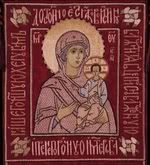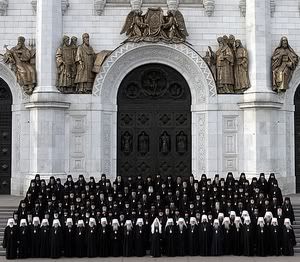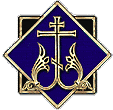Difference between revisions of "Taraskovyan Orthodox Church"
m (→Holy Synod) |
m (→Council of Archierei) |
||
| Line 60: | Line 60: | ||
====Council of Archierei==== | ====Council of Archierei==== | ||
{{Image|http://img.photobucket.com/albums/v77/Namellar/GDT/sobor_s.jpg|right|ChurchCouncil|The Council of Archierei in presence of the Patriarch of Vigvar and all Taraskovya.}} | {{Image|http://img.photobucket.com/albums/v77/Namellar/GDT/sobor_s.jpg|right|ChurchCouncil|The Council of Archierei in presence of the Patriarch of Vigvar and all Taraskovya.}} | ||
| − | The administrative body that reunites all of the Archierei of the Taraskovyan Orthodox Church and decides on most of the matters of the Church. For some of the most important matters, such as electing the Patriarch or deciding on canonization, the Council of Archierei is expanded to all members of the Church. | + | The Council of Archierei is the administrative body that reunites all of the Archierei of the Taraskovyan Orthodox Church and decides on most of the matters of the Church, an equivalent of a Synod of Bishops in most other Orthodox congregations. For some of the most important matters, such as electing the Patriarch or deciding on canonization, the Council of Archierei is expanded to all members of the Church. |
| − | In the Taraskovyan Orthodox Church, the rank of Archiereus is subdivided into Episcop(Bishop), Archiespiscop(Archbishop) | + | In the Taraskovyan Orthodox Church, the rank of ''Archiereus'' is subdivided into ''Episcop''(Bishop), ''Archiespiscop''(Archbishop) and ''Metropolite''. Metropolites are entrusted with the leadership over an [[Taraskovyan_Orthodox_Church#Eparchies_and_Exarchate|Eparchy]], whilst the Archiepiscops and Episcops often serve as vicars. It should be noted, however, that in the organisation of most Orthodox Churches, a ''Vicarius''(vicar) is an Archiereus who is not entrusted with an Eparchy and who aids a governing Archiereus in his tasks. |
| − | In the Taraskovyan | + | In the past, there were very few Metropolites, yet as the Taraskovyan population soared over generations, the existing administrative structure could no longer cope effectively with the amount of faithful. The Church had to either sharply increase the number of Eparchies, making them smaller and more easily governed, or preserve the ancestral partition. The Church kept the existing partition and chose to promote all governing Archierei to the ranks of Metropolites and assign vicars to aid them in governing. The number of Archiepiscops(if any) and Episcops(commonly present) under the authority of a Metropolite may vary depending on the importance of a specific Eparchy. |
| + | |||
| + | This system does not give one Metropolite more powers over an other Metropolite in the Church, neither does it give him any additional powers in the Council of Archierei. | ||
====High Court of the Church==== | ====High Court of the Church==== | ||
Revision as of 06:23, 30 September 2005
| Taraskovyan Orthodox Church Vigvar Patriarchate | ||||||
|---|---|---|---|---|---|---|
|
| ||||||
|
Approximately three quarters of the Taraskovyan population declare themselves as belonging to Eastern Orthodoxy. And the near entirety of those declare themselves as belonging to the Taraskovyan Orthodox Church, or the Vigvar Patriarchate as it is both official called and commonly referred to by the Taraskovyan population.
History of the Vigvar Patriarchate
The first roots of Christian faith in Tarasovka go back to the slaves that were brought in massively from beyond the oceans by Taraskath merchants. Being pagans at first, the slave labour force begun to slowly Christianize itself as more and more Christian slaves were brought in. The Taraskath leadership, as well as the Church of the Seven Deities, paid no attention to the proselytizing of the slaves and never did anything to hinder it.

After the end of the Strife, the advent of Mstislav Shakhovskoy as Grand Duke of Tarasovka, himself a Christian at first, and the abolition of slavery, Christianity was free to blossom throughout the country. The Christian community came under the jurisdiction of the Bishop of Constantinople and, with the break up of the Christian Church, remained loyal to the Eastern Rite.
Due to the fact that the overwhelming majority of the Taraskovyan Orthodox were of Russian Origin, Tarasovka quickly became an eparchy under the authority of the Metropolite of Moscow, who, by that time already, was de facto independent from the Patriarch of Constantinople.
As more and more Russian migrants arrived to Tarasovka, the Vigvar Eparchy was transformed into an Exarchate of the Russian Orthodox Church in 389 A.S. But as the influence of the Metropolite of Vigvar and all Taraskovya began to grow, so did the calls for autocephaly. And so, in 781 A.S., upon consensual agreement between the Moscow Patriarchy and the Exarchate of Vigvar, the Vigvar Patriarchate was created. The year of the achieving of autocephaly is considered to be the year of the founding of the Taraskovyan Orthodox Church, or the Vigvar Patriarchate as it is officially called.
Canonical Structure
Branches of Power
Patriarch
The Patriarch is the supreme authority of the Taraskovyan Orthodox Church. Elected for life by the Council of Archierei, he is aided in his task by the Holy Synod of the Vigvar Patriarchate.
At this time, the head of the Taraskovyan Orthodox Church is His Holiness Patriarch Nikon II of Vigvar and all Taraskovya.
Holy Synod
Unlike in most other Orthodox congregations, the Holy Synod of the Taraskovyan Orthodox Church is not the council of Bishop (see: Council of Archierei), but is an equivalent of a Chancellery to the Patriarch, to which the latter delegates a number of his daily tasks. The Holy Synod consists of nine members, four of which are permanently tied to a specific Eparchy:
- Metropolite of Uthar (Patriarchal Exarch to South Cardinia and Uthar), at this time His Beatitude Metropolite Dimitry
- Metropolite of Severovolost(Patriarchal Exarch to Svarog), at this time His Beatitude Metropolite Tikhon
- Metropolite of Amal, at this time His Eminence Metropolite Alexy
- Metropolite of Arkhangelsk and Namel-Cardin, at this time His Eminence Metropolite Innokentiy
The other five members are appointed by the Patriarch for a period of two years after which they are replaced. The exception is when the Patriarch decides to promote one of the five temporary members of the Synod to the post of Head of the Office for External Relations, in which case that member of the Holy Synod shall remain until dismissed by the Patriarch. This happens when the head of the Taraskovyan Church deems none of the four permanent members suitable for the post.
As of now, the Head of the Office for External Relations is His Eminence Metropolite Kirill of Tin-Vilena and Tal-Nathil.
Council of Archierei

The Council of Archierei is the administrative body that reunites all of the Archierei of the Taraskovyan Orthodox Church and decides on most of the matters of the Church, an equivalent of a Synod of Bishops in most other Orthodox congregations. For some of the most important matters, such as electing the Patriarch or deciding on canonization, the Council of Archierei is expanded to all members of the Church.
In the Taraskovyan Orthodox Church, the rank of Archiereus is subdivided into Episcop(Bishop), Archiespiscop(Archbishop) and Metropolite. Metropolites are entrusted with the leadership over an Eparchy, whilst the Archiepiscops and Episcops often serve as vicars. It should be noted, however, that in the organisation of most Orthodox Churches, a Vicarius(vicar) is an Archiereus who is not entrusted with an Eparchy and who aids a governing Archiereus in his tasks.
In the past, there were very few Metropolites, yet as the Taraskovyan population soared over generations, the existing administrative structure could no longer cope effectively with the amount of faithful. The Church had to either sharply increase the number of Eparchies, making them smaller and more easily governed, or preserve the ancestral partition. The Church kept the existing partition and chose to promote all governing Archierei to the ranks of Metropolites and assign vicars to aid them in governing. The number of Archiepiscops(if any) and Episcops(commonly present) under the authority of a Metropolite may vary depending on the importance of a specific Eparchy.
This system does not give one Metropolite more powers over an other Metropolite in the Church, neither does it give him any additional powers in the Council of Archierei.
High Court of the Church
This institution dedicates itself to examining the crimes of priests as well as resolving any disputes that are not in the competence of the Holy Synod or of the Council of Archierei. Nowadays, this Court is greatly limited by the law-courts of the Taraskovyan state and is often reduced to carrying out administrative punishments of members of the Church that have violated Church or national laws.
Constituencies
Eparchies in Tarasovka
An Eparchy is the equivalent of a Diocese in the organisation of an Eastern Orthodox Church, led by an Archiereus (a Metropolite in the Taraskovyan Orthodox Church). The Vigvar Patriarchate counts the following Eparchies inside of Tarasovka:
- Vigvar
- Amal
- Bogatyr
- Uith (comprising the Fiefdoms of Uith and Kshas-Uith)
- Arkhangelsk and Namel-Cardin (comprising the Fiefdoms of Tal-Nathir and Northern Cardinia)
- Keth
- Cardin
- Kem
- Elista
- Vladizapad (comprising the Fiefdoms of Zapadozemie and Novozemie)
- Kharit
- Srednegrad
- Shek’Tarad
- Seth (comprising the Fiefdoms of Zerth, Setar and Uil)
- Tin-Vilena and Tal-Nathil
- Var-Vilena
- Zlatograd
Exarchate of South Cardinia and Uthar
During the times when the Vortex Corporation was an independent state, many Taraskovyan Orthodox settled in the nation, which led the Vigvar Patriarchate to create the Exarchate of South Cardinia and Uthar. The Exarchate enjoyed a greater deal of autonomy than the eparchies in Tarasovka, however, when the Vortex Corporation was absorbed by the Taraskovyan Federation, the Exarchate found itself in the territory of the same nation in which the Patriarchate was. This has led the Council of Archierei to begin consultations on whether or not to upkeep the Exarchate’s status.
As of now, the Exarchate consists of the following Eparchies:
- Crayven
- Uthar
- Vishna
Exarchate of Svarog
The Exarchate of Svarog reunites the Taraskovyan Fiefdoms on the Planet Mars. The percentage of the Orthodox population is the most important in the Fiefdoms of Svarog and Dajdbog, with the Fiefdom of Stribog being distinct from the rest of the nation on ethnic and religious basis.
Taraskovyan Orthodox Church Abroad
The Vigvar Patriarchate watches over Taraskovyan Orthodox faithful throughout the world and has parishes in many countries. Most of the flock, however, consists of Taraskovyan expatriates.
Relations of the Church
Even if Orthodoxy does not have the status of State religion in Tarasovka, the influence of the Vigvar Patriarchate is tremendous on many aspects of the Taraskovyan society and Patriarch Nikon II is a highly respected personality for all Taraskovyans, even those who do not belong to the Taraskovyan Orthodox Church. One of the examples of the influence and power of the Patriarchate was the welcoming of Pantocratorian Greek Orthodox to the Grand Duchy centuries ago, following the interdiction of the Greek rite in the Empire and communion with Rome. The Taraskovyan Church extended its protection to the Orthodox brothers and helped the Greek Orthodox community exist autonomously throughout generations.
The Patriarchate has a very pragmatic and fructuous relationship with the Order of the Seven Deities (and, thus, with the Church of the Seven Deities), recognizing the importance of the ancestral faith proper to the original inhabitants of Tarasovka. This has led to some other Christian Churches outside of Tarasovka to condemn the Vigvar Patriarchate for collaborating with pagans and idol worshippers.
The Taraskovyan Orthodox Church tolerates the presence of Roman Catholics on its canonical territory, although it does tend to oppose any proselytizing undertaken by the latter vis-à-vis of the Taraskovyan population. It should be noted, however, that the ones who arise the most suspicion are not the Eastern rite Taraskovyan Catholics, but the Latin rite ones. The Patriarchate is also quite tolerant towards the presence of various Protestant churches and movements on its canonical territories, although it tends not to occupy itself much with the infinite supply of protestant factions that are simply impossible to follow.
The Vigvar Patriarchate shares a cordial and friendly relationship with the small Armenian Apostolic Church that is present in Tarasovka, as well as with the small Serbian and Bulgarian Orthodox Churches that are also present on the Taraskovyan soil. Although, as years go by, the already small communities of these Churches become even thinner as people simply tend to follow the Taraskovyan Orthodox Church for reasons of practicality.

